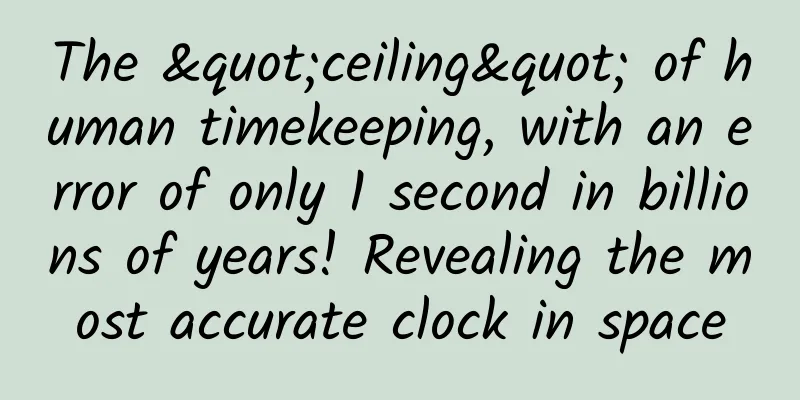The "ceiling" of human timekeeping, with an error of only 1 second in billions of years! Revealing the most accurate clock in space

|
Last October, with the successful launch of the Mengtian experimental module and the smooth completion of rendezvous and docking and transfer, the basic "T" configuration of the Chinese space station was assembled in orbit. Subsequently, the eight scientific experiment cabinets of the Mengtian experimental module were powered on and started in orbit. The Mengtian Experimental Module is an experimental module in the Chinese space station that undertakes precision physics experiments. We know that the more precise the physics experiment, the higher the requirement for time accuracy. For this reason, the Mengtian Experimental Module is equipped with the world's first set of space cold atomic clocks, which is also the most accurate time and frequency system in space, with an accuracy of about 1 second in 5 billion years! What kind of clock is an atomic clock? Why can it provide such accurate time? Next, let's learn about the principles and applications of atomic clocks! The great role of atomic clocks As science progresses, people find that the accuracy of quartz clocks (the most accurate timers before the invention of atomic clocks) is not enough to support the needs of scientific research. The pillars of modern physics are relativity and quantum mechanics, which are almost the same as the conclusions of Newtonian mechanics at a macroscopic scale. In other words, we cannot perceive the difference between Newtonian mechanics and relativity and quantum mechanics in the macroscopic world. However, the difference between relativity and Newtonian mechanics is apparent at 15 decimal places, which cannot be measured by quartz clocks. According to Einstein's general theory of relativity, gravity distorts space and time and also causes time dilation. According to this theory, the time at the top of Mount Everest is 1 second faster than the time at sea level on average for more than 80,000 years. This is far beyond the measurement accuracy of quartz clocks. As we all know, China has independently developed the Beidou satellite navigation system, which provides all-weather, all-day, high-precision positioning, navigation and timing services for users around the world. Satellite navigation positioning is achieved by transmitting signals through electromagnetic waves. The speed of electromagnetic waves in a vacuum is about 3×108 meters per second. This speed multiplied by the time the signal propagates is the distance the signal travels. Because this speed is so fast, a 1-second error in the timing clock will result in a 300,000-kilometer deviation in ground positioning! Therefore, for the global satellite positioning system, in order to provide sufficiently accurate navigation services, it is necessary to have sufficiently accurate clocks. The atomic clock we are going to introduce can achieve this high-precision timing, and it has become the commanding height technology for global satellite positioning. High-precision time and frequency experimental cabinet installed in the "Mengtian" experimental cabin (I) Definition of "seconds" To understand the timing principle of atomic clocks, we must first understand the definition of the time unit "second". The current International System of Units uses the definition of "second" given at the 13th International Conference on Weights and Measures held in 1967, which is 9,192,631,770 times the period of the electromagnetic wave radiated when the cesium-133 atom transitions between two hyperfine energy levels in the non-perturbed ground state. We know that the basic unit of matter is the atom, which is composed of a nucleus and electrons. According to the Bohr model, the electrons in an atom move around the nucleus and can only move in specific, discrete orbits. The electrons in each orbit have discrete energies, which are "energy levels". Electrons can transition between different orbits. When electrons absorb electromagnetic waves of a specific frequency, they can transition from a low energy level to a high energy level; when electrons transition from a high energy level to a low energy level, they can also radiate electromagnetic waves of a specific frequency. During the transition process, the frequency of the electromagnetic waves absorbed or radiated by the electrons corresponds one-to-one to the energy level difference between the transition energy levels, so the frequency and period of the electromagnetic waves radiated when the cesium-133 atom transitions between two hyperfine energy levels in the non-perturbed ground state are also fixed. Physicists stipulate that 9,192,631,770 times this fixed period is a "second". High-precision time and frequency experimental cabinet installed in the "Mengtian" experimental cabin (Part 2) The principle of atomic clock After knowing the definition of "second", the principle of atomic clock is easier to understand. Everyone has used a radio, right? The working principle of an atomic clock is actually the same as the process of using a radio. Suppose we want to listen to a radio station with a frequency of 100MHz, we must first adjust the frequency to around 100MHz. When the frequency is close to 100MHz, some fuzzy sounds will come from the radio. If the previous frequency was less than 100MHz, we will find that the received sound is getting clearer and clearer as we increase the frequency; if the previous frequency was greater than 100MHz, we will also find that the received sound is getting clearer and clearer as we decrease the frequency. In the process of increasing and decreasing the frequency, the modulated frequency gets closer and closer to 100MHz. When the received sound is the clearest, that frequency is exactly the 100MHz we want. In atomic clocks, there is also a process similar to frequency modulation. First, we use the first state-selecting magnet to select the part at the lower energy level from a large number of cesium atoms at two hyperfine energy levels. Then, these atoms, under the action of the collimator, form an atomic beam and pass through the microwave resonant cavity without colliding with each other. The microwave resonant cavity radiates electromagnetic waves with a frequency close to 9 192 631 770 Hz. Under the action of electromagnetic waves, some atoms passing through the microwave resonant cavity will transition from low energy levels to high energy levels. After the atoms pass through the microwave resonant cavity, the second state-selecting magnet will separate the high-energy-level atoms from the low-energy-level atoms, and the detector will detect the number of atoms at the high energy level. The closer the frequency of the electromagnetic waves in the microwave resonant cavity is to 9 192 631 770 Hz, the more atoms will transition to high energy levels, and the more high-energy-level atoms will be detected by the detector. When the number of atoms detected at high energy levels reaches the maximum, the frequency of the electromagnetic wave in the microwave cavity is exactly 9 192 631 770 Hz. We can then use the time-frequency signal that controls the microwave cavity as our timing standard. The atomic clock is like a radio in the hands of a physicist. If you can understand the principles of the radio, you can definitely understand the principles of the atomic clock. An atom transitions between two energy levels Why is it the most precise timekeeping device? Why can an atomic clock have an error of only 1 second in about 5 billion years? This has to do with the principle of timekeeping. Timing is to measure the number of times a certain periodic motion occurs, and the time unit is a specification of the number of times a specific periodic motion occurs. The ancients stuck a stick into the ground and observed the periodic changes in the position of the stick's shadow from sunrise to sunset, and then marked the time of the day according to the different positions of the shadow during the day. This kind of clock is called a "sundial". In the development of timing technology, people also used flowing water and flowing sand to measure the elapsed time, and created water clocks and hourglasses. The movement cycles of sundials, water clocks, and hourglasses are all unstable, and are greatly affected by factors such as seasons, temperature, and friction. This leads to uncertainty in the period and frequency of periodic motion, and the timing is naturally inaccurate. Later, people invented more stable mechanical clocks, which are less affected by factors such as friction, and because their movement frequency is very large, this error is greatly reduced. A mechanical clock that moves 10,000 times in 1 hour, the time for the accounting mechanical clock to move 10,000 times is 1 hour. In other words, if one time is counted less, the timing will only be one ten-thousandth of an hour slower. Now the error of a better mechanical clock in a day is only a dozen seconds. Later, people made more accurate quartz clocks. Quartz clocks rely on the oscillation periodic motion of quartz crystals under the action of electric current, which can occur 32,768 times in 1 second. Compared with mechanical clocks, quartz clocks have more stable cycles and more accurate timing. An ordinary quartz clock will run for a day with an error of no more than 2 seconds. After the quartz clock, the atomic clock was also invented. The atomic clock relies on the periodic motion of electromagnetic waves emitted by atoms during transitions between energy levels. The frequency of this periodic motion is very stable and will not change due to external influences. It is the most suitable periodic motion for timing. In 1 second, a cesium atomic clock can move 9.1 billion times, a strontium atomic clock can move 430 trillion times, and an ytterbium atomic clock can move 518 trillion times. Therefore, the accuracy of the space cold atomic clock group in the "Mengtian" experimental cabin can reach an error of 1 second in about 5 billion years! To sum up, the reasons why atomic clocks are so precise can be roughly divided into two points: one is the stability of periodic motion. Periodic motion other than atomic clocks is easily affected by external factors. The second is the high frequency of periodic motion. The number of periodic motions that can occur in an atomic clock within 1 second is in the billions, far exceeding the periodic motion of other timers. By Liu Yuzhu, Professor and Doctoral Supervisor at Nanjing University of Information Science and Technology and Zhai Ruoyu, Nanjing University of Information Science and Technology |
<<: Are mobile phones and computers the culprits of myopia? The main reason may be this →
>>: What kind of fear and trauma do elephants who are born without tusks go through?
Recommend
Sugar-free cola has sweet taste but no "soul"? This food expert found the scientific basis
When you are feeling down, will a cup of cola or ...
China Brand Day, the 25 most popular Chinese brands among the public!
Today, May 10th, is the second " China Brand...
When doing promotion, how can we achieve systematic thinking and rhythmic control?
This article will explain from the thinking level...
An introduction to 360 Fengwu industry direct advertising promotion product styles!
In order to better promote for you, Fengwu Advanc...
The bitter winter is gone, and the plum blossoms of spring are in season
Produced by: Science Popularization China Author:...
A "tornado" was created in a cooking pot?! Netizens were excited about the topic
recently Woman creates tornado in cooking pan It ...
Nutritionist's special reminder! Zibo barbecue is delicious, but you need to follow these 8 points to eat it healthily!
As the weather warms up, the barbecue industry ha...
Remdesivir clinical trial! What is remdesivir? What is the price?
As of February 7, a total of 31,214 cases of nove...
Experience in optimizing game performance
[[149217]] Introduction to Optimization When it c...
Why is Samsung the only one still using stylus when there were so many of them on the street?
When it comes to mobile phone styluses, I believe...
The Alpha S5, which starts at RMB 176,800, is a product with a good balance of quality and price, but its brand is its biggest shortcoming.
During this period, BYD was the most active manuf...
Email inventor Tom Linson dies at 74
Ray Tomlinson, the American computer programmer w...
Himalaya FM-AARRR traffic funnel model analysis report!
With the rise of knowledge payment, audio payment...
Mental illness isn't just caused by brain chemicals
Leviathan Press: Generally speaking, people who p...
Mobile Framework: Lettuce, a simple but not simple mobile development framework
Lettuce is a small and powerful mobile developmen...









